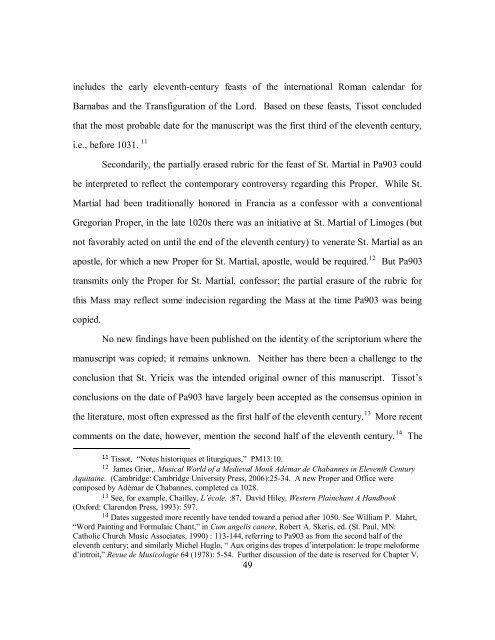Front Matter Template - The University of Texas at Austin
Front Matter Template - The University of Texas at Austin
Front Matter Template - The University of Texas at Austin
You also want an ePaper? Increase the reach of your titles
YUMPU automatically turns print PDFs into web optimized ePapers that Google loves.
includes the early eleventh-century feasts <strong>of</strong> the intern<strong>at</strong>ional Roman calendar for<br />
Barnabas and the Transfigur<strong>at</strong>ion <strong>of</strong> the Lord. Based on these feasts, Tissot concluded<br />
th<strong>at</strong> the most probable d<strong>at</strong>e for the manuscript was the first third <strong>of</strong> the eleventh century,<br />
i.e., before 1031. 11<br />
Secondarily, the partially erased rubric for the feast <strong>of</strong> St. Martial in Pa903 could<br />
be interpreted to reflect the contemporary controversy regarding this Proper. While St.<br />
Martial had been traditionally honored in Francia as a confessor with a conventional<br />
Gregorian Proper, in the l<strong>at</strong>e 1020s there was an initi<strong>at</strong>ive <strong>at</strong> St. Martial <strong>of</strong> Limoges (but<br />
not favorably acted on until the end <strong>of</strong> the eleventh century) to vener<strong>at</strong>e St. Martial as an<br />
apostle, for which a new Proper for St. Martial, apostle, would be required. 12 But Pa903<br />
transmits only the Proper for St. Martial, confessor; the partial erasure <strong>of</strong> the rubric for<br />
this Mass may reflect some indecision regarding the Mass <strong>at</strong> the time Pa903 was being<br />
copied.<br />
No new findings have been published on the identity <strong>of</strong> the scriptorium where the<br />
manuscript was copied; it remains unknown. Neither has there been a challenge to the<br />
conclusion th<strong>at</strong> St. Yrieix was the intended original owner <strong>of</strong> this manuscript. Tissot‟s<br />
conclusions on the d<strong>at</strong>e <strong>of</strong> Pa903 have largely been accepted as the consensus opinion in<br />
the liter<strong>at</strong>ure, most <strong>of</strong>ten expressed as the first half <strong>of</strong> the eleventh century. 13 More recent<br />
comments on the d<strong>at</strong>e, however, mention the second half <strong>of</strong> the eleventh century. 14 <strong>The</strong><br />
49<br />
11 Tissot, “Notes historiques et liturgiques,” PM13:10.<br />
12 James Grier,. Musical World <strong>of</strong> a Medieval Monk Adémar de Chabannes in Eleventh Century<br />
Aquitaine. (Cambridge: Cambridge <strong>University</strong> Press, 2006):25-34. A new Proper and Office were<br />
composed by Adémar de Chabannes, completed ca 1028.<br />
13 See, for example, Chailley, L’école. :87, David Hiley, Western Plainchant A Handbook<br />
(Oxford: Clarendon Press, 1993): 597.<br />
14 D<strong>at</strong>es suggested more recently have tended toward a period after 1050. See William P. Mahrt,<br />
“Word Painting and Formulaic Chant,” in Cum angelis canere, Robert A. Skeris, ed. (St. Paul, MN:<br />
C<strong>at</strong>holic Church Music Associ<strong>at</strong>es, 1990) : 113-144, referring to Pa903 as from the second half <strong>of</strong> the<br />
eleventh century; and similarly Michel Huglo, “ Aux origins des tropes d’interpol<strong>at</strong>ion: le trope mel<strong>of</strong>orme<br />
d’introit,” Revue de Musicologie 64 (1978): 5-54. Further discussion <strong>of</strong> the d<strong>at</strong>e is reserved for Chapter V.

















